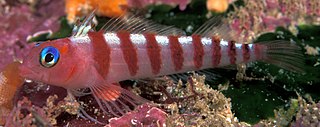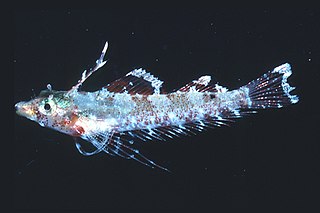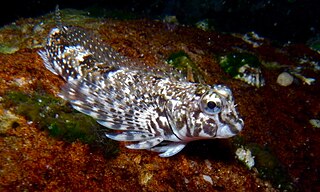
Ruanoho is a genus of triplefin blennies. It is known from the southwestern Pacific Ocean off New Zealand. The generic name is a compound noun derived from the Māori rua meaning either "fish" or "hole" and noho meaning to "dwell" which refers to the habit of the species in this genus to shelter under rocks or within crevices.

The cryptic triplefin, Cryptichthys jojettae, is a triplefin of the family Tripterygiidae, the only member of the genus Cryptichthys, found around the coast of New Zealand. It length is up to 6 cm. The specific name honours a former staff member at the National Museum of New Zealand, Jorjette Drost, who participated in collecting specimens with Hardy.

Forsterygion is a genus of triplefins in the family Tripterygiidae native to coastal New Zealand, but also introduced to Tasmania, Australia.

Notoclinops is the name of a genus of triplefins in the family Tripterygiidae from New Zealand.
Lepidonectes is a genus of triplefins in the family Tripterygiidae. They are found in the eastern Pacific Ocean.

Norfolkia is a genus of triplefins in the family Tripterygiidae. They are found I the Indo-Pacific region.

The largemouth triplefin, Ucla xenogrammus, is a fish of the family Tripterygiidae and only member of the genus Ucla, found in the Pacific Ocean from Viet Nam, the Philippines, Palau and the Caroline Islands to Papua New Guinea, Australia, and the Solomon Islands, Fiji, Tonga, east to American Samoa and Rapa Iti, at depths of between 2 and 41 metres. Its length is up to about 47 millimetres (1.9 in). The generic name was coined by ichthyologist Richard Heinrich Rosenblatt in his unpublished dissertation of 1959 from the University of California Los Angeles and it is the initials of that institution, it was formally applied by Holleman in 1993.

Zaniolepis, the combfishes, is a genus of marine ray-finned fish, it is one of two genera in the family Zaniolepididae. These fishes are native to the eastern Pacific Ocean. Z. frenata that was a source of food to the Native American inhabitants of San Nicolas Island off the coast of southern California, United States during the Middle Holocene.
Enneapterygius larsonae, known commonly as the Western Australian black-head triplefin, is a species of triplefin blenny in the genus Enneapterygius. It was described by the German ichthyologist Ronald Fricke in 1994. The specific name honours Helen K. Larson, the Curator of Fishes at the Museum and Art Gallery of the Northern Territory in Darwin, Australia, who collected the type.

Enneapterygius mirabilis, the miracle triplefin, is a species of triplefin blenny in the genus Enneapterygius. It was described by Ronald Fricke in 1994 who gave it the specific name mirabilis, meaning "admirable", because its notable large pectoral fins and first dorsal fin were pretty.
Enneapterygius williamsi, known commonly as the William's triplefin, is a species of triplefin blenny in the genus Enneapterygius. It was described by Ronald Fricke in 1997. Its specific name honours the collector of the type, the ichthyologist Jeffrey T. Williams of the Smithsonian Institution.
Enneapterygius ziegleri, known commonly as the Ziegler's triplefin, is a species of triplefin blenny in the genus Enneapterygius. It was described by Ronald Fricke in 1994. Its specific name honours Bernhard Ziegler (1929-2013), a paleontologist and Director of the State Museum of Natural History in Stuttgart, Germany. This species occurs in the Timor Sea of Indonesia and East Timor and in the Philippines.

Helcogramma hudsoni, known commonly as the Hudson's triplefin, is a species of triplefin blenny in the genus Helcogramma. It was described by David Starr Jordan and Alvin Seale in 1906, the specific name honouring the illustrator of their monograph on Samoan fishes, R.L. Hudson. This species is found in the western Pacific Ocean where it has been recorded from the Izu Islands, Ryukyu Islands, Savo Island, New Caledonia, Vanuatu, Fiji, and Samoa.
Helcogramma randalli, Randall's triplefin, is a species of triplefin blenny in the genus Helcogramma. It was described by Jeffrey T. Williams and Jeffrey C. Howe in 2003 and named it in honour of the ichthyologist John Ernest Randall of the Bishop Museum in Honolulu who collected all of the known specimens. This species occurs in the western Pacific Ocean and is endemic to the islands of central Indonesia such as Bali, Lombok, Timor and Komodo.
Helcogramma springeri, known commonly as the Springer's triplefin, is a species of triplefin blenny in the genus Helcogramma. It was described by P.E. Hadley Hansen in 1986. The specific name honours the ichthyologist Victor G. Springer of the National Museum of Natural History. This species is found in the western Pacific Ocean from Indonesia and the Philippines to northern Australia, including the Great Barrier Reef.

Lepidoblennius haplodactylus, known commonly as the eastern jumping blenny, is a species of triplefin blenny in the genus Lepidoblennius. It was described by Franz Steindachner in 1867 and is the type species of the genus Lepidoblennius.
Lepidonectes clarkhubbsi, known commonly as the signal triplefin, is a species of triplefin blenny in the genus Lepidonectes. It was described by William Albert Bussing in 1991 and he gave it a specific name which honours the American ichthyologist Clark Hubbs (1921–2008). This species occurs in the eastern Pacific Ocean where it is found off Costa Rica and Panama. The signal triplefin is found on rocky shores where it feeds on very small invertebrates and algae.
Matanui is a genus of triplefin blennies, they are endemic to New Zealand.
Norfolkia thomasi, known commonly as the Thomas' triplefin, is a species of triplefin blenny in the genus Norfolkia. It was described by Gilbert Percy Whitley in 1964, naming it in honour of Leonard Rees Thomas who organised the Australian Museum's 1962 Swain Reefs Expedition. The hemispherical eggs of the Thomas' triplefin are covered in sticky threads that help anchor them in the algae on their nesting sites. This adaption helps insure the safety of the eggs. One the eggs hatch the larvae that emerge are planktonic and they stick to shallow waters near the shore. The matured Thomas' triplefin then ventures out into the coral reef and intertidal pools. This species is found in the western Pacific Ocean from the Ryukyu Islands to the Tuamoto Archipelago, in Australia it is distributed from the northern Great Barrier Reef south to Byron Bay, New South Wales.
Springerichthys kulbickii, known commonly as the Kulbicki's triplefin, is a species of triplefin blenny in the genus Springerichthys. It was described by Ronald Fricke and John E. Randall in 1994, honouring the fish ecologist reef-fish ecologist Michel L. Kulbicki of L'Office de la Recherche Scientifique et Technique d’Outre-Mer in Nouméa, who collected type in New Caledonia, in its specific name. Kulbicki's triplefin is found in the southwestern Pacific Ocean from Queensland, Australia across the central Pacific to the Samoa, where it is found on rocky and coral reefs down to 15 metres (49 ft) in depth.










